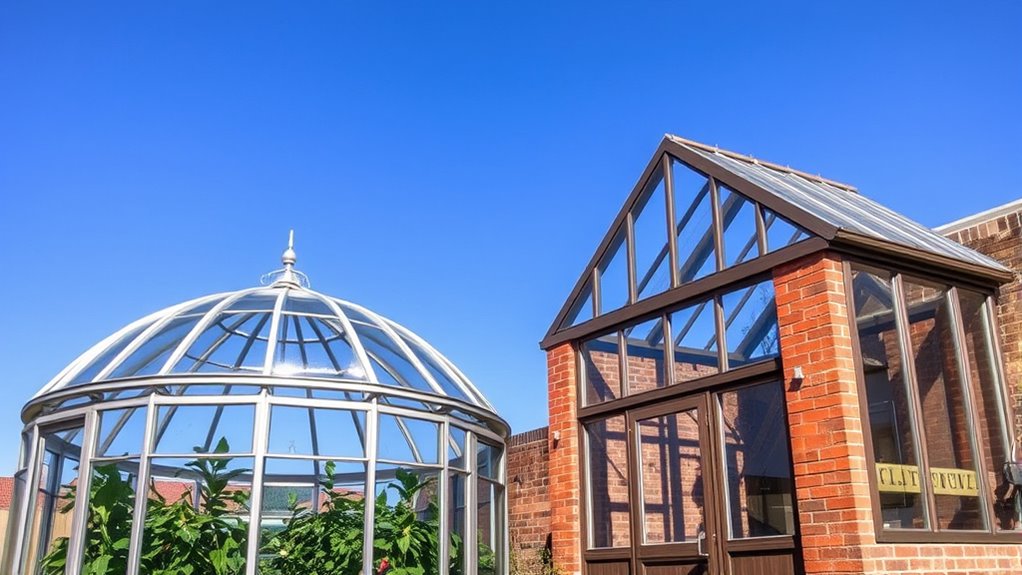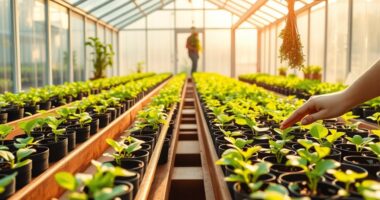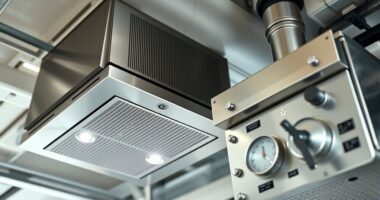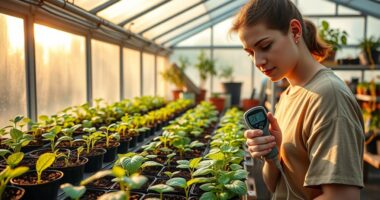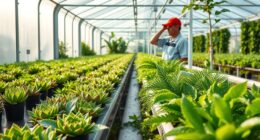When choosing between a freestanding and a lean-to greenhouse, consider your space and gardening needs. Freestanding greenhouses are standalone structures that offer flexibility in size, ventilation, and climate control, but they may require more space and investment. Lean-to greenhouses attach directly to existing buildings, saving space and sharing insulation, but might limit customization. To understand which suits your environment best, explore the unique benefits of each type and their material options.
Key Takeaways
- Freestanding greenhouses are standalone structures offering flexible placement and size options.
- Lean-to greenhouses attach directly to existing buildings, saving space in limited areas.
- Freestanding models typically provide better ventilation and climate control customization.
- Lean-to greenhouses benefit from existing building insulation and climate management systems.
- Choice depends on available space, budget, and desired climate control flexibility.
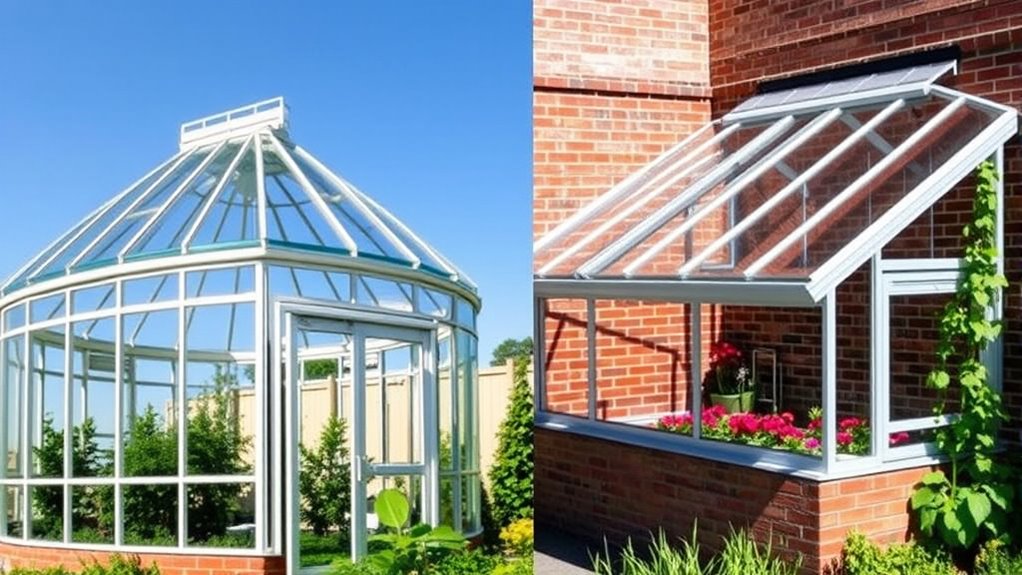
Greenhouses come in many varieties, each designed to suit different gardening needs and environments. When choosing between different types, one of the most important considerations is how well the structure allows you to manage climate control. Climate control is essential for maintaining ideal temperatures and humidity levels, which directly impact plant growth. To achieve this, material selection plays a vital role. Different materials, such as glass, polycarbonate, or plastic, have unique properties that influence insulation, light transmission, and durability. For instance, glass offers excellent clarity and light transmission but can be more fragile and expensive. Polycarbonate is lightweight, tough, and provides good insulation, making it a popular choice for many gardeners. Your decision on materials will determine how effectively your greenhouse can retain heat in winter or stay cool during the summer, influencing the overall climate control capabilities. Additionally, understanding the impact of materials on greenhouse efficiency can help you choose the most suitable options for your specific climate and gardening goals.
Choosing the right greenhouse materials like glass or polycarbonate is key to effective climate control and plant health.
When considering freestanding greenhouses, you’re looking at structures that stand alone, giving you flexibility in placement and size. These greenhouses often feature a more robust framework, which allows for extensive customization in material selection. Because they’re not attached to a building, they typically have better ventilation options and can be designed with advanced climate control systems, like automated vents or heating units. Their size and independence mean you can tailor them to specific climate needs, ensuring your plants thrive regardless of external weather conditions. However, freestanding greenhouses may require more space and initial investment, especially if you want to incorporate high-quality materials for ideal climate regulation.
On the other hand, lean-to greenhouses are attached directly to an existing structure, such as a house or garage. Their design maximizes space efficiency, making them ideal if you have limited outdoor area. Material selection is equally critical here because the shared wall can influence insulation and heat retention. Since they’re connected to a building, lean-tos often benefit from the existing structure’s climate control features, like heating or shading systems. This can make managing temperature and humidity easier but also means you need to pay close attention to the materials used in the greenhouse walls to prevent heat loss or unwanted drafts. The connection to a building can be advantageous for energy efficiency but may also restrict some customization options compared to freestanding models.
Both types can be equipped with various climate control mechanisms, but your choice hinges on available space, budget, and how much control you want over environmental conditions. Selecting the right materials for your greenhouse, whether for a freestanding or lean-to design, ensures you can maximize climate control and create a suitable environment for your plants to flourish.
Frequently Asked Questions
What Are the Typical Costs Associated With Each Greenhouse Type?
The cost comparison between freestanding and lean-to greenhouses varies mainly in initial investment. Freestanding models typically cost more upfront due to larger size and independent structures, often ranging from $1,000 to over $10,000. Lean-to greenhouses are usually cheaper initially, costing between $500 and $5,000, since they share walls with existing structures. Your choice depends on your budget and space, but remember, higher initial costs often mean more customization and space.
How Do Maintenance Requirements Differ Between Freestanding and Lean-To Greenhouses?
You’ll find that maintenance differs between freestanding and lean-to greenhouses. Freestanding structures require more attention to ventilation systems and pest management, as they’re exposed on all sides. You need to regularly check and adjust ventilation to prevent overheating and control pests effectively. Lean-to greenhouses are easier to maintain, with less ventilation concern, but you still need routine pest management to keep plants healthy and reduce disease risk.
Which Greenhouse Type Offers Better Insulation for Extreme Climates?
You’ll find that lean-to greenhouses generally offer better insulation efficiency, making them more suitable for extreme climates. Studies show they retain heat up to 20% more than freestanding models, thanks to their shared wall, which reduces heat loss. This design enhances climate adaptability, helping you maintain stable temperatures during harsh weather. If you face cold or hot extremes, a lean-to greenhouse provides a more energy-efficient and resilient environment.
Can a Greenhouse Be Easily Expanded or Modified Later?
Yes, you can usually expand or modify a greenhouse later, but modification challenges depend on its design. Freestanding greenhouses often offer better expansion flexibility because you can add sections easily. Lean-to greenhouses might be more limited due to their connection to existing structures. To minimize future modification challenges, choose a flexible design upfront and consider how you’ll want to expand or adapt your greenhouse over time.
What Are the Best Locations for Installing Each Type of Greenhouse?
Imagine installing a freestanding greenhouse in a sunny, open area with good site suitability, like a backyard with minimal shade. For lean-to greenhouses, choose a south-facing wall of your house or building to maximize sunlight exposure and save space. Both types thrive where they receive ample sunlight and have stable, well-drained soil. Your choice depends on available space, existing structures, and sunlight availability to guarantee ideal plant growth.
Conclusion
Now that you know the differences between freestanding and lean-to greenhouses, you’re equipped to choose the perfect fit for your gardening dreams. Whether you want the freedom of a standalone structure or the space-saving efficiency of a lean-to, your decision can turn your garden into a lush paradise. Don’t underestimate the power of the right greenhouse—it could be the key to transforming your gardening efforts into a thriving, magical oasis that rivals the most wondrous landscapes in the world.
